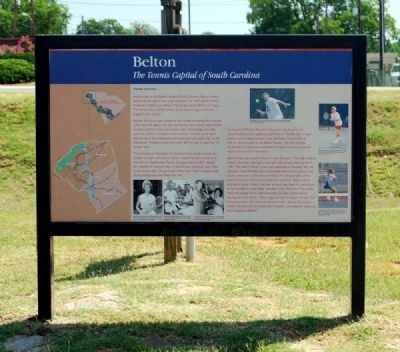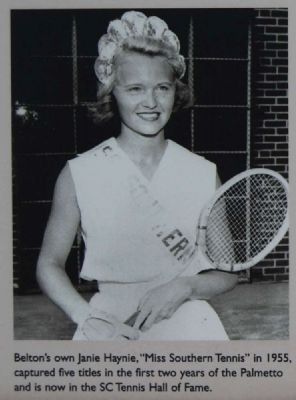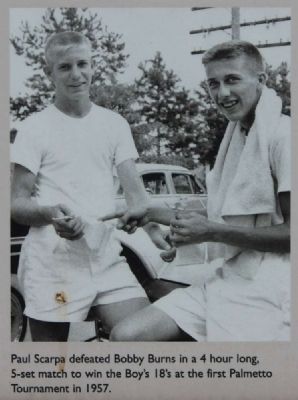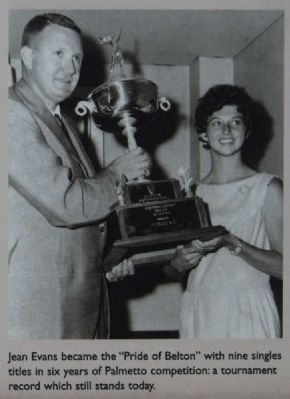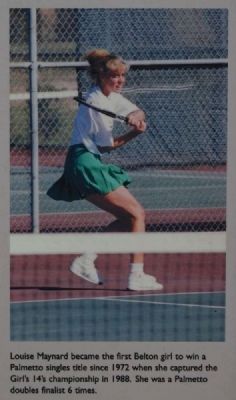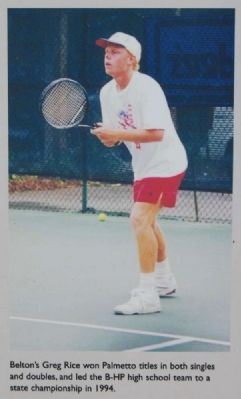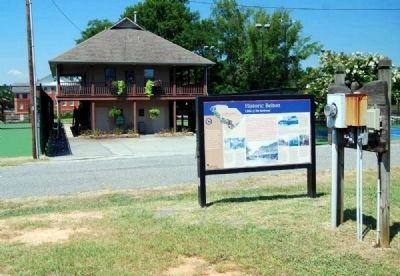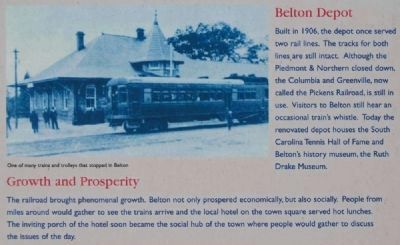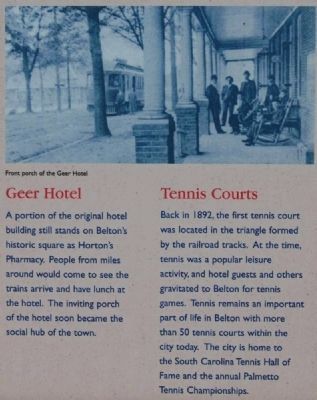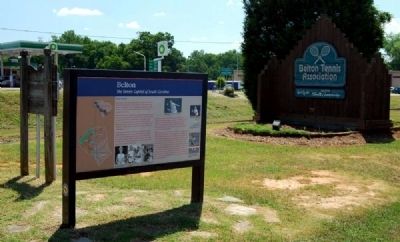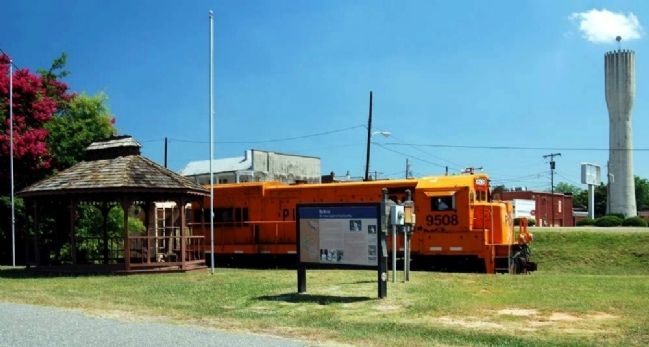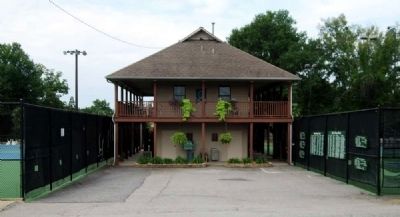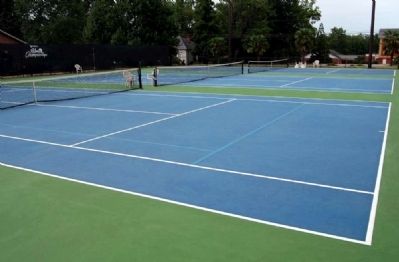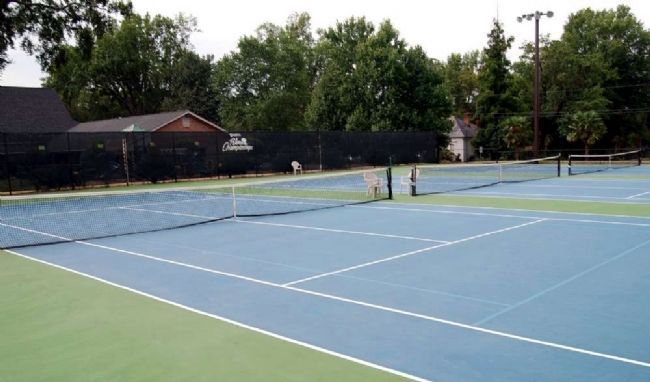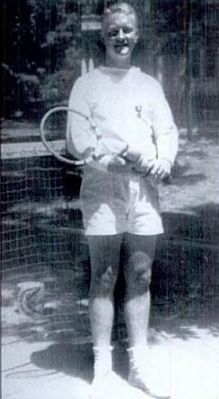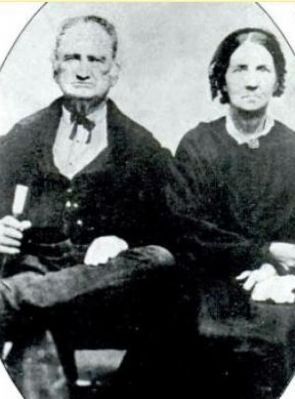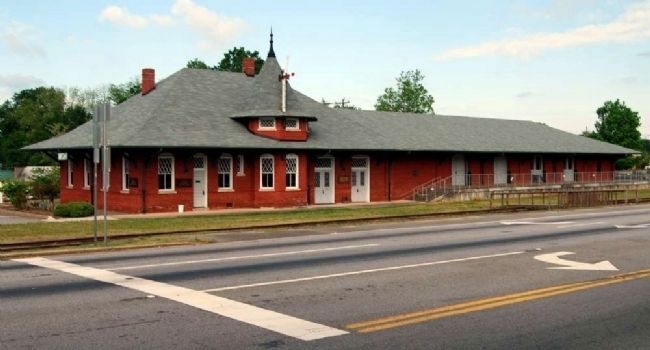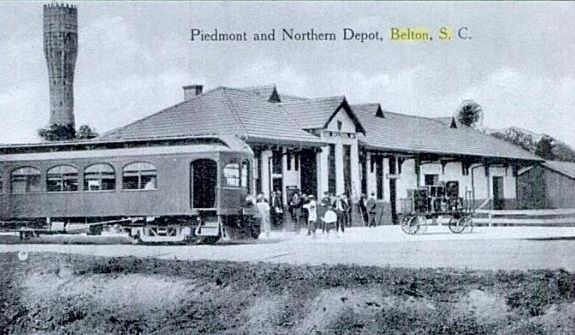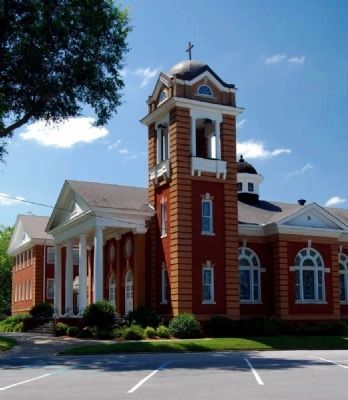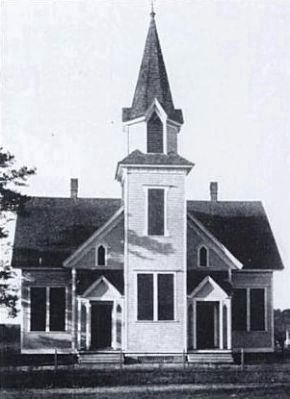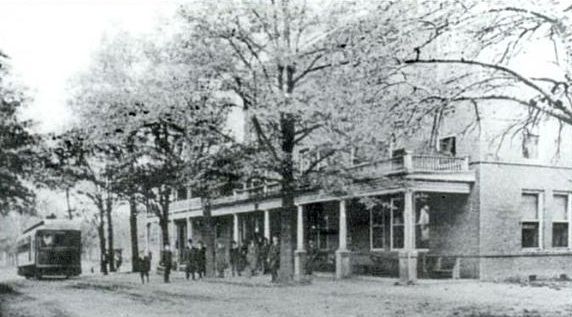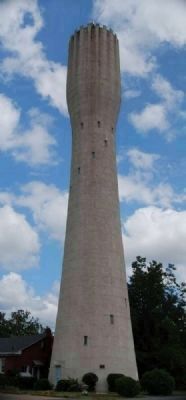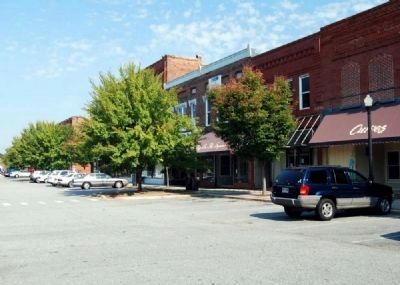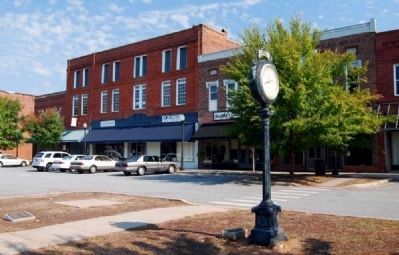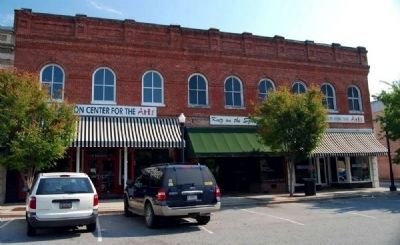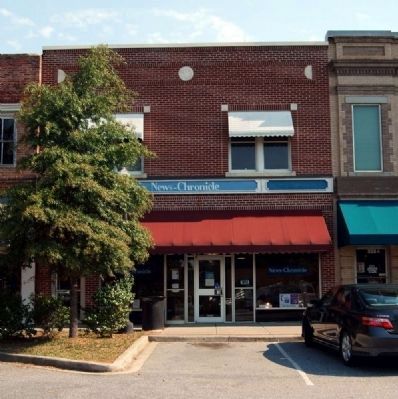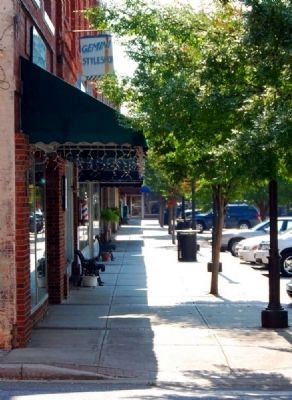Belton in Anderson County, South Carolina — The American South (South Atlantic)
Belton / Historic Belton
Belton
The Tennis Capital of South Carolina
Tennis Anyone?
Long know as the Tennis Capital of South Carolina, Belton's tennis history can be traced back over 110 years. An 1892 edition of the Anderson Intelligencer stated, "The young men of Belton are happy. The stores close at 6:00 and the clerks have an opportunity to engage in lawn tennis."
Belton's first court was located in the triangle formed by the railroad tracks near the depot and later the famous Town Court stood where the Belton Tennis Center is located today. Tennis began to really catch on in Belton during the time between the two world wars. Belton's youth dominated play and produced many state high school champions. The high school girl's team did not lose a match for 14 straight years.
The formation of the Belton Tennis Association combined with the number of public and private courts enabled the town to become the home of the Palmetto Tennis Championships in 1957. Belton girls sparkled in the early days of the Palmetto and won many titles in the 50s and 60s. The girl's high school team won 9 straight state championships between 1958 and 1967.
During the 1970s the Palmetto Championship became the state's national junior qualifying tournament. The 80s saw a major addition to the Belton tennis scene, the South Carolina Tennis Hall of Fame, located in the Belton Depot. The Hall of Fame showcases portraits and memorabilia of South Carolina's greatest tennis championships and volunteers.
Belton tennis continued to flourish over the years. The Hall of Fame Classic, the state's top high school girls tournament, was started in 1987. The Belton Tennis Center was expanded in the early 90s, the Palmetto Championships grew and prosperous, and local players and teams continued to win championships. Providing decades of the state's best junior tennis is a proud local tradition. Belton tennis provides a sense of place that may be best described by a tennis pro as he watched a young player compete in the Palmetto: "The sweet smell and feeling of this match reminds me what is good about learning to enjoy tennis. What is good is that it happens to you. You become a player. You become someone with a chance of winning a match. You become someone with a history...you become someone who had played Belton!"
Historic Belton
Child of the Railroad
Origins
The town of Belton was chartered in 1855 as a "child of the railroad." Judge John "Belton" O'Neal and a group of prominent leaders of South Carolina formed the Columbia and greenville Railroad Company to connect Charleston with Cincinnati by way of the Blue Ridge Railway.
Work on this project began in 1847 and it soon became evident that the company could save $100,000 by following a path west of the Saluda River, crossing near Pelzer near Greenville. This met with extreme opposition from the Anderson stockholders. In order to retain their financial support, it was decided that a spur line be run from the courthouse at Anderson to connect with the regular line at Sugar Hill (now called Belton). This would take place on the property owned by Dr. George Brown who also donated land for the depot and town square. The decision to form this rail line sparked interest in many to locate to this junction and, thus, Belton was born.
Belton Depot
Built in 1906, the depot once served two rail lines. The tracks for both lines are still intact. Although the Piedmont & Northern closed down, the Columbia and Greenville, now called the Pickens Railroad, is still in use. Visitors to Belton still near an occasional train's whistle. Today the renovated depot houses the South Carolina Tennis Hall of Fame and Belton's history museum, the Ruth Drake Museum.
Growth and Prosperity
The railroad brought phenomenal growth. Belton now only prospered economically, but also socially. People from miles around would gather to see the trains arrive and the local hotel on the town square served hot lunches. The inviting porch of the hotel
soon became the social hub of the town where people would gather to discuss the issues of the day.
Geer Hotel
A portion of the original hotel building still stands on Belton's historic square as Horton's Pharmacy. People from miles around would come to see the trains arrive and have lunch at the hotel. The inviting porch of the hotel soon became the social hub of the town.
Tennis Courts
Back in 1892, the first tennis court was located in the triangle formed by the railroad tracks. At the time, tennis was a popular leisure activity, and hotel guests and others gravitated to Belton for tennis games. Tennis remains an important part of life in Belton which more than 50 tennis courts within the city today. The city is home to the South Carolina Tennis Hall of Fame and the annual Palmetto Tennis Championships.
Belton's Living History
The first brick building on the square was built in 1877 and the second and third floors of this building became the opera house known as Stringer's Hall. The introduction of the movies established the Pastime Theater which brought the best silent movies to town. The town square also boasted a skating rink and bowling alley.
Local Landmarks
Many historic landmarks still stand today as reminders of Belton's rich past. One is the First Baptist Church. The first phase
of the church was completed on October 11, 1861 and the beauty of its architecture can still be enjoyed today. rising above the city's skyline is the famous standpipe water tower, a landmark that can be seen for miles. The tower was built in 1908 and still stores part of the city's water supply.
Living Traditions
Belton's cultural history comes to life through bluegrass concerts here at the depot on the second and fourth Saturdays of each month, and during the annual Standpipe Festival each fall. Local artists' work can be seen at the Belton Center for the arts located on the square.
Erected by South Carolina Heritage Corridor.
Topics and series. This historical marker is listed in these topic lists: Railroads & Streetcars • Sports. In addition, it is included in the South Carolina Heritage Corridor series list. A significant historical month for this entry is October 1921.
Location. 34° 31.267′ N, 82° 29.583′ W. Marker is in Belton, South Carolina, in Anderson County. Marker is on Holmes Street, on the left when traveling south. Touch for map. Marker is in this post office area: Belton SC 29627, United States of America. Touch for directions.
Other nearby markers. At least 10 other markers are within 5 miles of this marker, measured as the crow flies. Greenville & Columbia RR / Belton (about 300 feet away, measured in a direct line); Belton Depot (about 600 feet away); The Belton Standpipe
(about 600 feet away); Belton Academy / Central School (approx. 0.2 miles away); Chamberlain-Kay House (approx. ¼ mile away); First Baptist Church of Belton (approx. 0.4 miles away); Belton Veterans Memorial (approx. 0.6 miles away); Rocky River Baptist Association Headquarters (approx. 1½ miles away); Dorchester Baptist Church World War II Veterans Plaque (approx. 2.3 miles away); Cooley's Bridge (approx. 5 miles away). Touch for a list and map of all markers in Belton.
Also see . . .
1. Belton Area Partnership. Official page of the Belton Area Partnership. (Submitted on September 10, 2010, by Brian Scott of Anderson, South Carolina.)
2. Belton, South Carolina. Belton is a city in eastern Anderson County, South Carolina, United States. (Submitted on September 10, 2010, by Brian Scott of Anderson, South Carolina.)
3. Jaynie Haynie Hentz. South Carolina Tennis Patrons Foundation website entry:
Considered the most outstanding tennis player ever from Belton, a town rich in tennis tradition. (Submitted on September 10, 2010, by Brian Scott of Anderson, South Carolina.)
Additional commentary.
1. Judge John Belton O'Neall
As a part of the introduction, it may not be amiss that something should be known of the author. He is the son of Hugh O'Neall and Anne Kelly, his wife, both of whom were members of the Society of Friends, on Bush River, Newberry District, South Carolina, and consequently he was, by his birthright, a member. The Society there has for nearly half a century been, from the diminution of its members, incapable of transacting business; and he is, therefore, still one of them, although he knows perfectly well, from his habits, pursuits and mode of life, that he has forfeited his right to be called "a Friend"; yet he confesses to a great partiality for Friends, when in deed and in truth they are such.
His ancestry on both sides were Irish, his paternal great-grandfather belonging to the ancient house of O'Neall of Shane's Castle, Antrim, Ireland. His maternal grandfather, Samuel Kelly, was of King's County, and his grandmother, Hannah Belton, was of Queen's County, Ireland; so that he may rank as a full-blooded Irish-American.
He was born on Wednesday, 10th of April, 1793 (about half a mile below Bobo's Mills, on Bush River. At his earliest recollection his father removed to the Mills, and there his boyhood was spent.
He
began to go to school when he was five years old. A young man, the son of a friend of his father's, boarded at his house and went to "Master Howe" (as the teacher, James Howe, was familiarly called), about one mile and a half distant. He took the childlike pupil with him day by day, carrying him across the branches on his back. The first shock of death which he ever experienced was in the decease of this young gentleman, Captain Abraham Parkins, in October, 1802. He (young O'Neall) learned rapidly, but his subsequent life satisfies him that he went to school at least two years too soon. His nerves were unstrung by an attack of what was then called nervous fever, when he was about three years old, and which had the effect to render his hand so unsteady as to make him incapable of writing a good hand, although taught by the best teachers of penmanship with whom he was acquainted.
The other children of his father were girls. They were all remarkable for talents. His eldest sister, Abigail, went to school with him and learned more rapidly than he did. She is still alive, and is the widow of John Caldwell, Esq. His two next sisters, Rebbecca and Hannah, have long been tenants of the "silent house." His youngest sister, Sarah Ford O'Neall, is still alive, and is a member of the Society of Friends.
In 1804 a library society was organized at Newberry, of which his father was a member. The books were selected and bought in the city of Boston by Elijah Hammond, the father of Senator Hammond. This afforded to young O'Neall the opportunity of reading, a taste for which he had acquired by Mr. Howe having permitted him to read, under his direction, his books, of which he had a pretty good selection. He recollects to this day with what avidity he read the first book placed in his hands—the "Pilgrim's Progress."
He continued to go to English schools, with slight interruptions, until 1808. Occasionally he was employed as a clerk in his father's store, where he learned to abhor the liquor traffic. At the schools to which he went for the first thirteen years of his school life he learned to spell and read well, and to write an indifferent hand, and came to understand arithmetic perfectly.
He acquired great facility in memorizing promptly whatever was put in his hands. He committed to memory in an hour the 9th chapter of 2d Kings. In May, 1808, he became a pupil of the Newberry Academy, then under the care of the Rev. John Foster. He pushed his young pupil forward much too rapidly. By January he had him reading Virgil without at all understanding it as he should have done. In January, 1909, Charles Strong, of the class of 1808, South Carolina College, became the preceptor in that year and the next. Young O'Neall became a thorough Latin
scholar, and was sufficiently instructed in Greek and all the branches of English to prepare him for the junior class of the South Carolina College. During this time he acquired the habit of extemporaneous speaking by practicing to speak every night, after he had got his lessons for the next day, before his uncle and grandmother, with whom he boarded at Springfield.
In the year 1810 his father was deprived of his reason, and this kept him home from school for several months to endeavor to close up, satisfactorily, his deranged mercantile affairs. But all was in vain. Bankruptcy came down upon him, and his creditors nearly crushed every hope by suing him in his unfortunate insane condition, and forcing his property to a sale at an immense sacrifice. Thus his family were turned out of doors, and had it not been for the kindness of his father's bachelor brother, must have been left without even a shelter for their heads.
In February, 1811, young O'Neall was allowed to enter the junior class of the South Carolina College. In December, 1812, he graduated with the second honor of that institution. His diploma bears date 7th December, 1812, and is signed by Jonathan Maxcy, S. T. D., Praeses.; Thos. Park, Ling. Prof.; B. R. Montgomery, D. D., Phil, and Log. Prof.; Georgius Blackburn, A. M., Matt, and Astron. Prof.; and by Henry Middleton, Governor and President of the Board, and twenty-two trustees, only one of whom, John J. Chappell, is alive.
The expenses of his collegiate education were paid in part by himself, and the balance out of his father's dilapidated estate by one of his committeemen, and which was not allowed in his accounts. His father (in 1813) recovered his reason, and, in gathering up the wrecks of his fortune, succeeded in being able to reimburse Mr. Caldwell such sums as he had expended on his son's education.
In 1813, for about six months, O'Neall taught in the Newberry Academy. At the end of that time he devoted himself to the study of the law in the office of John Caldwell, Esq. At that time Anderson Crenshaw, Esq., afterwards Judge Crenshaw, of Alabama, lived in the village; he gave O'Neall free access to his library, and imparted to him much valuable instruction.
A debating society then existed at Newberry, to which the young men, and many of the middle-aged, belonged. A meeting was held every Saturday, and subjects debated with much energy. O'Neall then improved his habits of extemporaneous speaking very much.
In August, 1813, O'Neall performed, at the muster of a demibrigade, in Frost's old field, his first military duty, as a member of the artillery company under the command of Captain McCreless; the militia, under the orders of the Governor, were classified. The company to which he belonged was placed in the first class. That class was called into the State's service in March, 1814, and marched from Camp Alston, four miles below Pocotaligo, in Beaufort District, where there was about as much necessity for troops as there would be in time of war at Chalk Hill, near Columbia.
The first class were mustered into service under the command of Colonel Starling Tucker, at Newberry, on the 1st, 2d and 3d days of March, by Major Thomas Wright, brigade major of the then Second, now Tenth, Brigade of Militia; and, on the 4th, commenced their march for Camp Alston. O'Neall was appointed judge advocate for the command, but was allowed to remain as part of the artillery company. The line of march was by the way of Lee's Ferry, Bord's in Lexington, Pine Log on Edisto, the White Pond in Barnwell, Barnwell Court-house, Burford's Bridge across the Salkehatchie, thence across many swamps to Pocotaligo and Camp Alston. The campaign was inglorious, and closed about the 1st of April. Of all that was interesting, a narrative is given in the life of Solicitor Stark.
A few weeks after his return home (in May, 1814,) he was admitted to the practice of law and equity. The circumstances attending his examination and admission are narrated in the sketches of Judges Grimke, Nott and Brevard, and of John D. Witherspoon, Esq. He immediately entered into partnership with John Caldwell, Esq. (who was the cashier of the Branch Bank of the State at Columbia, and had removed to Columbia). He opened his office at Newberry, and from the commencement was honored with a large and lucrative practice.
In October of that year a volunteer company of artillery (in the place of that in which he had served at Camp Alston, and which had been disbanded,) was raised at Newberry, and he was elected captain. To this point in his life he always refers as conferring more pleasure and pride than any other.
His first equity speech was made at Laurens, before Chancellor DeSaussure, at the June term of 1814 for Washington Equity District. The Chancellor's approving smile was of great benefit to him then, and so was his friendship ever after. His first law speech was made at Union Court-house in October, 1814, in a malicious prosecution case, notice of which was made in the sketch of James McKibben. When the case was going on, Judge Crenshaw, then a practicing lawyer, said to the defendant, James Duncan, son of Alexander Duncan: "You had better employ me; the young man who is about to speak against you is not known to you." "Never mind," was the old man's reply, "Cousin Josey (meaning Colonel Joseph Gist) will fix them." But the old gentleman learned, in the sequel, by a verdict of two hundred dollars, that "the race was not always to the swift, nor the
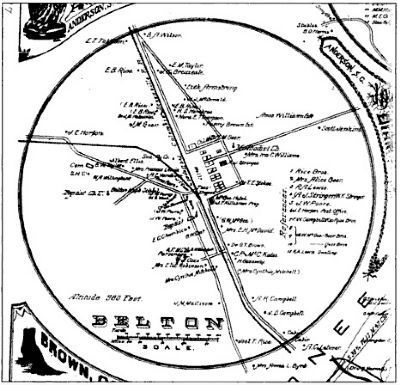
Belton by Alison A. Darby (2004), 1897
13. Historic Map of Belton
The layout of the square appears in this 1897 map that was published as part of an advertisement. The businesses noted include Rice Oil Mill; the mercantile companies of R.A. Lewis, A.J. Stringer, J.W. Poore, F.W. Campbell, and the Geer Brothers; the post office run by J.E. Horton; the railroad depot; and main home sites.
In October, 1815, he had the misfortune to be visited with an attack of fever; he, however, kept pace with the business of his office, in the midst of successive and daily intermittent attacks. At court, by the blessing of God, he was able to maintain his usual stand at the bar. At the October election of 1816 he was returned third out of four members of the House of Representatives from Newberry District. This gave him the opportunity of being more generally known, and probably furthered his views of advancement; but if he had the privilege to live his life over he would not seek such a position so early in life. On the 2d December, 1816, the degree of Master of Arts was conferred on him by the South Carolina College. On the 7th of August, in 1817, he was elected from the rank of captain to that of colonel of the Eighth and Thirty-ninth Regiments of militia. He was enthusiastically fond of the military, and soon raised his regiment to a proud position as militia. The whole regiment were devotedly attached to their colonel. Like many other young men, his vanity was played upon by professed friends, and he was presumptuous enough to offer for major-general against his commander and friend, Brigadier-General Tucker. That he was defeated was exactly what he deserved. The officers of his own regiment evinced their fidelity by giving him an unanimous vote. This consoled their young colonel in his defeat, and has ever since been gratefully referred to.
In the December session of the General Assembly of that year he voted for the increase of the judges' salaries; the consequence was that at the elections of 1818 and 1820 he was left at home. This period of rest from political pursuits, he thinks, was of immense advantage to him; it made him a much better lawyer, and increased his reputation and business.
In 1816 he was appointed by Governor Pickens one of his aids, with the rank of lieutenant-colonel; this appointment he resigned in consequence of his election as colonel. In December, 1817, he was elected a trustee of his alma mater, the South Carolina College; and he has filled that office ever since, with the exception of a year, from December, 1821, to December, 1822. Thus for forty years he has sedulously watched over the interests of that great institution.
On the 25th of June, 1818, he was married to Helen, eldest daughter of Captain Sampson Pope and Sarah Strother, his wife, of Edgefield. For forty-one years they have together toiled through life enjoying much of happiness, and, in the death of all their children, drinking the cup of sorrow to its dregs.
In June, 1820, his grandmother, Hannah Kelly, died; by her will she devised to him "Springfield"; thither, in August of that year, he removed, and there he has resided ever since, adding to it many adjoining farms, and the mills on Bush River, just above the forty-fifth line railroad crossing.
In 1822 he was returned second to the House of Representatives in the General Assembly of South Carolina, and, by successive biennial elections, he was returned in 1824 and 1826. In 1824 and 1826 he was elected Speaker of the House of Representatives without opposition. During the four years in which he held that great office there was only a single appeal from his decisions, and in that his decision was sustained. No reading clerk existed at his first term; the consequence was that he read all bills, reports and resolutions. He had a wonderful facility in this respect. His voice was clear, his enunciation distinct; he read with great ease and rapidity any writing presented to him. His quick and ready eye, and a prompt understanding of the scope of the writer, constituted the whole secret of his art of reading; being able to make out a word going before and another after an obscure writing enabled him to read the sentence.
A laughable incident between him and his friend, Hugh S. Legare, may be here stated. The practice to read every report and the documents had been so altered as merely to require the reading of reports. The Speaker had left the chair and placed in it his friend, Colonel Gregg, while he sought a short relaxation. Returning, he found the House in a warm discussion on rescinding the recent rule and returning to the former practice. At the instance of Colonel Gregg, the Speaker resumed the chair and presented the question; and the House, by a large vote, refused to rescind the rule. When the vote was announced, H. L. Pinckney, Esq., asked if a member might not still call for the reading of the documents. He was answered "yes." In the course of a few moments a favorable report was read, and Mr. Legare called for the reading of the documents, which was done. The Speaker, seeing his object, determined on his course. In a few moments a favorable report of the Committee on Pensions was read. Mr. Legare rose and said: "I claim the reading of the documents." The Speaker, in a mild and pleasant
manner, said: "Will the gentleman come to the chair and read for his own information and that of the House?" He could not resist the request. He came to the chair with obvious reluctance. A large auditory was present; the gallery was full of ladies. Fortunately for the Speaker's purpose, the petition was a long one, from Brushy Creek Fork, Chester District, in a very cramped and difficult hand. Mr. Legare began his task in a very halting, hesitating manner; at every sentence he had to be prompted. The members enjoyed the scene much; the titter soon became a broad, loud laugh, which extended to the galleries. The late Judge Axson, with his broad, laughter-loving Dutch face, placed himself right under the Speaker's desk, and every-now-and-then cried out: "The gentleman don't read loud enough." After a long, protracted and blundering reading, the petition was read through; one out of the nine accompanying affidavits was handed to Mr. Legare; with much difficulty he mastered the words "Before me personally appeared, A.B."; halting there, he said to the Speaker: "It is all d nonsense"; who replied: "If you are satisfied, the House is." He abandoned the reading; the House concurred in the report, and the Speaker, after this reading lesson of Mr. Legare's, as Judge Butler facetiously termed it, was never asked to read any more documents.
In February, 1823, he was elected brigadier-general
of the Tenth Brigade, Fifth Division of the South Carolina Militia; and on the 20th of August, 1825, he was elected and commissioned major-general of the Fifth Division. In that and the previous election for brigadier-general the officers of the Thirty-ninth Regiment gave him an unanimous vote. In his election as majorgeneral, he succeeded in rising over the head of a friend and relative—a much older officer and a most worthy man—BrigadierGeneral Dawkins, of Union. His commission as major-general is signed by his much-valued friend, Governor Manning, and is, therefore, carefully preserved.
In 1827 the appropriation of ten thousand dollars for the relief of Mr. Randolph was made. The Speaker was known to be favorable to the measure, though he did not vote. In 1828 the people of Newberry, who have always been remarkable for seizing upon matters of money appropriated as objections to their members, that which no other district could have been persuaded to do, refused to return the Speaker, and, of consequence, lost the honor of having that officer as one of their representatives.
On the 20th of December, 1828, John Belton O'Neall was elected and commissioned as an associate judge. He immediately accepted the great trust, qualified, and entered on its duties. He rode the Southern, Western and Middle Circuits, and commenced, in the fall of 1830, the Eastern
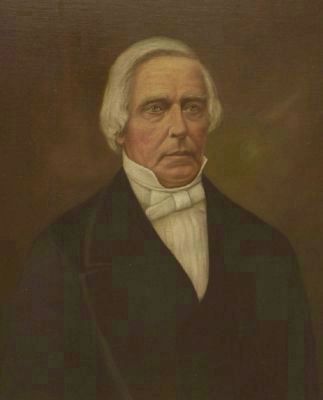
Photographed By University of South Carolina, School of Law, June 27, 2003
19. Judge John Belton O'Neall
1793-1863
1793-1863
Asst Just of S.C. Supreme Court 1828-1830 Court of Appeals Judge 1830-1835
Chief Justice of S.C. Supreme Court
President of the Southern Baptist Convention 1858-1863
On the first day of December, 1830, Judge O'Neall was elected a judge of the Court of Appeals, and entered immediately upon its duties. With Johnson and Harper he encountered and performed the labors of the Court of Appeals—Herculean as they were—until December, 1835. The extent of them may be judged from a reference to 2 Bailey, 1 and 2 Hill, Bailey's Equity, 3 Rich., 1 and 2 Hill's Chancery Reports, Richardson's Equity Cases.
The decision, The State ex parte McCrady vs. Hunt, 2 Hill, so displeased the dominant party that the Court of Appeals, which had done more to give symmetry to the law than had ever been known before, was abolished, and Johnson and Harper assigned to equity and O'Neall to the law. He has ever since then given most of his attention and labors to the courts. The fact is, he has neglecetd his own affairs, and much injured his own estate, to serve the people. In May, 1850, on the death of Judge Richardson, he became president of the Court of Law Appeals and of the Court of Errors. His recorded labors, from December, 1835, are to be seen in 3 Hill, Dudley, Rice, 1 and 2 McMullan, Cheves, 1 and 2 Speer, 1st, 2d, 3d, 4th, 5th, 6th, 7th, 8th, 9th, 10th, llth Richardson, and 1st, 2d, 3d, 4th and 5th Strobhart.
In 1846 the degree of LL. D. was conferred on him at Columbia College, District of Columbia, and was repeated a few years since at Wake Forest, North Carolina.
In May, 1847, he was elected president of the Greenville and Columbia Railroad. Aided by an unfaltering devotion, he succeeded in carrying the enterprise successfully forward to Anderson, and within eighteen miles of Greenville, when, in May, 1853, he surrendered the work to other hands. Afterwards the work had to be carried forward by the individual credit of the president and his friend and endorser, Colonel Simeon Fair. 'At different times himself and all the directors were bound for more than one hundred thousand dollars. When the great freshet of 1852 broke down more than thirty miles of the road, and Wm. Spencer Brown, the talented and energetic chief engineer, was drowned, there devolved upon the president a work requiring sleepless vigilance and determined energy; that he was enabled to overcome all obstacles is cause of devout gratitude to God, which he has always acknowledged.
On 31st December, 1832, to save a friend, he abandoned the use of spirituous liquors, and, in June following, gave up the use of tobacco. To these two causes he ascribes his health and ability to perform more labor than most men at his time of life can accomplish. He joined, soon after, the Head's Spring Temperance Society, Newberry District, where his membership now is, and of which he is president. He became a teetotaller, and in December, 1841, he was appointed president of the State Temperance Society, which office he still holds. In 1849 he joined the Sons of Temperance, Butler Division, No. 16, at Newberry. He was elected G. W. P. of the Grand Division of South Carolina, October, 1850; and in June, 1852, at the city of Richmond, Virginia, he was elected and installed M. W. P. of the Sons of Temperance of North America. He attended, in 1853 and 1854, the annual meetings at Chicago, Illinois, and St. John's, New Brunswick. Then he surrendered his office to his successor, Samuel L. Telby, of St. John's. In the spring of 1834 the Judge and his wife lost, by the scarlet fever, two of their lovely little girls.
In 1837 he was elected president of the Newberry Baptist Bible Society. To this office he has annually been elected. Much good has been accomplished by this society under his direction. He is now the president of the Bible Board of the Baptist State Convention, of which body (the Baptist State Convention) he was elected president in July, 1858, and again in 1859.
He was elected president of the Newberry District Agricultural Society in 1839, and has been annually elected ever since. The good accomplished by that society is known by the fact that Newberry has reclaimed her wasted fields and made more and better improvements in agriculture than any other district in the State. The society has, once or twice, been on the verge of dissolution, but the people of Newberry know too well its importance to permit it to perish.
On the 5th of August, 1857, the crowning sorrow of their lives occurred to the Judge and his wife. Then their excellent daughter, Sarah Strother Harrington, the wife of Dr. Harrington, their only surviving child, was taken from them by death. They are consoled by the fact that she was a Christian, and that she has left seven representatives (four daughters and three sons), whom may God spare to comfort and assist their grandparents, and to become good and useful women and men.
Judge O'Neall has written and labored much for his fellowmen. He has always believed where he could contribute even a mite to knowledge, education, temperance, religion and agriculture,
it was his duty to make the effort. He wrote, in 1818, many articles on the increase of the judges' salaries, signed Cato; in 1840 he wrote the "Drunkard's Looking Glass," and afterwards the "Wanderer," with many other subsequent fugitive essays and letters in the "Temperance Advocate," the Newberry "Rising Sun," the Greenville "Patriot," Greenville "Patriot and Mountaineer," and the "Southern Enterprise." He wrote reminiscences of the Revolution for the "Southern Literary Register," Revolutionary poetry for the "Orion," and a sketch of Joseph M. Jenkins for the "Magnolia." He has delivered innumerable addresses on temperance, education, Sunday schools, and railroads. He has permitted to be published an oration on public education, delivered before the Clariosophic Society, incorporate of the South Carolina College; a fourth-of-July oration in 1817, and another on the fourth of July, 1827, on the death of Jefferson; another, on education, before Erskine College, at the commencement in 1842; another, on Female Institute; another, on Public Speaking, before Davidson College, in North Carolina, in 1851. He has published, this year, the "Annals of Newberry," and now is about to give "Sketches of the Bench and Bar of South Carolina." He gave to the people of South Carolina a "Digest of the Negro Law" in 1848. He is sensible that he has worked hard and endeavored to do good. If he has succeeded, then every wish of his heart will be gratified; and he will only add, may he be succeeded by others more, much more, useful than he has been. Chief Justice O'Neall died 23d December, 1863. (Source: South Carolina Bench and Bar, Volume 1 by Ulysses Robert Brooks (1908) pgs 21-36.)
— Submitted September 26, 2010, by Brian Scott of Anderson, South Carolina.
2. Dr. George Reece Brown
Dr. George Reece Brown (born 1800 and died 1881) is shown here with his second wife, Maria Louisa Horton, whom he married in 1844. Brown grew up in the Calhoun Community (present-day Shady Grove area), worked for Maj. Aaron Broyles in his store, earned enough money to obtain his medical degree at Transylvania University in Lexington, Kentucky, and returned to marry his childhood sweetheart Edney Broyles in 1824. In 1830, he purchased a 374-acre tract that would eventually become the city of Belton. He sat in the legislature from 1852 to 1856 and, in addition to his extensive medical practice, took on apprentices who read medicine under him. Most of all, he enjoyed overseeing the land that he cultivated. When talk of the railroad project broke out, Brown had his brother-in-law John Horton survey the land for a town, setting aside lots for a school and church. His daughter Josephine had the privilege of naming the town. She chose Belton in honor of the president and promoter of the Greenville and Columbia Railroad, Judge John Belton O'Neall.
— Submitted September 26, 2010, by Brian Scott of Anderson, South Carolina.
3. E.B. "Fluffy" Rice: Most Responsible for Belton as the Tennis Capital of South Carolina
E.B. "Fluffy" Rice is known not only for his skill on the court, but also for his leadership and support of local and state tennis programs and tournaments. At six years of age, he began playing tennis on the court behind his home. Rice helped to form the Belton Tennis Club in 1954. During his tenure as president of that organization, he helped raise $10,000 to convert the town courts to rubico and personally financed a third court. "It was not uncommon in the 1950s," said a junior tennis player, "to find businessmen like Fluffy Rice out on the court during the middle of the day, giving tips and pointers to us teenagers, and challenging us to a game."
In 1955, Rice helped organize the first Piedmont Championships, which became the Palmetto Championships two years later, and assisted with the tournaments in some capacity until his death. In 1991, he spearheaded a project to build two more courts and a tennis clubhouse. Raising over $180,000, the facility was dedicated in June 1992, with Rice having the honor of receiving the first serve on the new courts. He was inducted into the South Carolina Tennis Hall of Fame, located in the historic Depot. (Source: Belton by Alison Ashley Darby (2004), pg 73.)
— Submitted October 6, 2010, by Brian Scott of Anderson, South Carolina.
4. Janie Haynie Hentz: A Tennis Aficionado
Considered the most impressive player ever to have come out of Belton, Janie Haynie Hentz won her first state girls' high school championship as a seventh grader. She played No. 1 on the Southern Junior Wrightman Cup Team and captained that team for two years. She won over 20 championships during her playing career, including the Palmetto Championships, the North Carolina Open, and the Southern Championships. She eventually attained a No. 8 ranking in the nation. She is an inductee to the South Carolina Tennis Hall of Fame. (Source: Belton by Alison Ashley Darby (2004), pg 74.)
— Submitted October 6, 2010, by Brian Scott of Anderson, South Carolina.
5. First Baptist Church of Belton, South Carolina
First Baptist Church of Belton was organized in 1861, eight years after the Greenville and Columbia
railroad center of Belton was founded. The first 1-room structure was built and dedicated on November 2, 1862. Rev. Amaziah Rice was the first pastor. The second sanctuary above was built by J.H. Wren of Due west in 1888 at a cost of $2,325. The third edifice was erected in 1911. (Source: South Carolina Postcards, Vol. IX: Anderson County, by Howard Woody (2004).)
— Submitted October 6, 2010, by Brian Scott of Anderson, South Carolina.
6. Belton (Geer) Hotel
George E. Coughlan and James P. Wilson were granted a franchise in June 1902 to operate an electric interurban car with one terminal at or near Greenville and the other within the city of Anderson. The Belton Town Council granted permission to use such streets as necessary to operate the line efficiently, including Main Street, and Belton granted access to another railway system. The electric trolleys inexpensively carried passengers on the 11-mile run from the porch of the Belton Hotel to Anderson. In fact, around 1905, many an Andersonian and his family tool the Interurban to Belton after church on Sunday, ate a fine meal at the hotel, and returned home on the trolley, all for around $2.80. (Source: Belton by Alison A. Darby (2004).)
— Submitted October 6, 2010, by Brian Scott of Anderson, South Carolina.
7. The Piedmont and Northern Depot
The Greenville, Spartanburg, and Anderson Railway, predecessor of the P&N, completed its main line from Greenwood to Belton terminal by 1912. By 1914, the section between Greenville and Spartanburg was constructed, and final consolidation of the railway system occurred in June of that year. The railway was renamed the Piedmont and Northern. This depot was torn down in the 1980s. (Source: Belton by Alison A. Darby (2004).)
— Submitted October 6, 2010, by Brian Scott of Anderson, South Carolina.
Credits. This page was last revised on May 19, 2022. It was originally submitted on September 10, 2010, by Brian Scott of Anderson, South Carolina. This page has been viewed 3,591 times since then and 130 times this year. Photos: 1, 2, 3, 4, 5, 6, 7, 8, 9, 10, 11, 12. submitted on September 10, 2010, by Brian Scott of Anderson, South Carolina. 13. submitted on October 6, 2010, by Brian Scott of Anderson, South Carolina. 14, 15, 16. submitted on September 10, 2010, by Brian Scott of Anderson, South Carolina. 17. submitted on October 6, 2010, by Brian Scott of Anderson, South Carolina. 18, 19. submitted on September 26, 2010, by Brian Scott of Anderson, South Carolina. 20. submitted on May 21, 2010, by Brian Scott of Anderson, South Carolina. 21. submitted on September 26, 2010, by Brian Scott of Anderson, South Carolina. 22. submitted on September 10, 2010, by Brian Scott of Anderson, South Carolina. 23, 24. submitted on September 26, 2010, by Brian Scott of Anderson, South Carolina. 25. submitted on May 25, 2010, by Brian Scott of Anderson, South Carolina. 26, 27, 28, 29, 30. submitted on October 13, 2010, by Brian Scott of Anderson, South Carolina.
